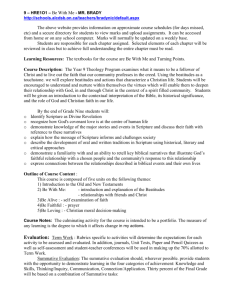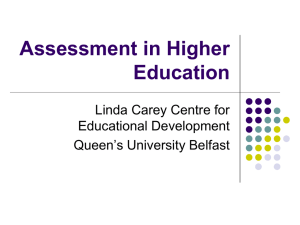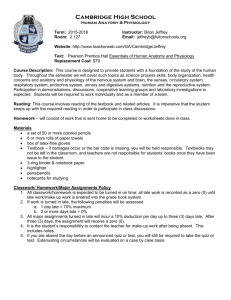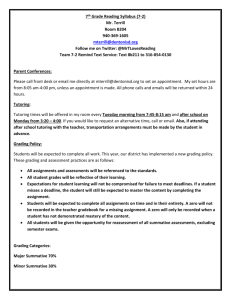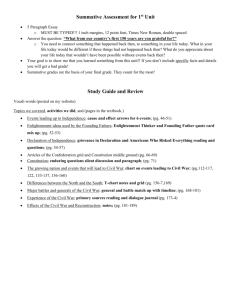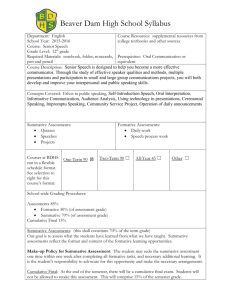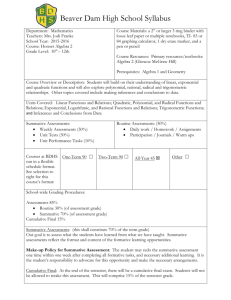Course Outline – Communications Technology
advertisement
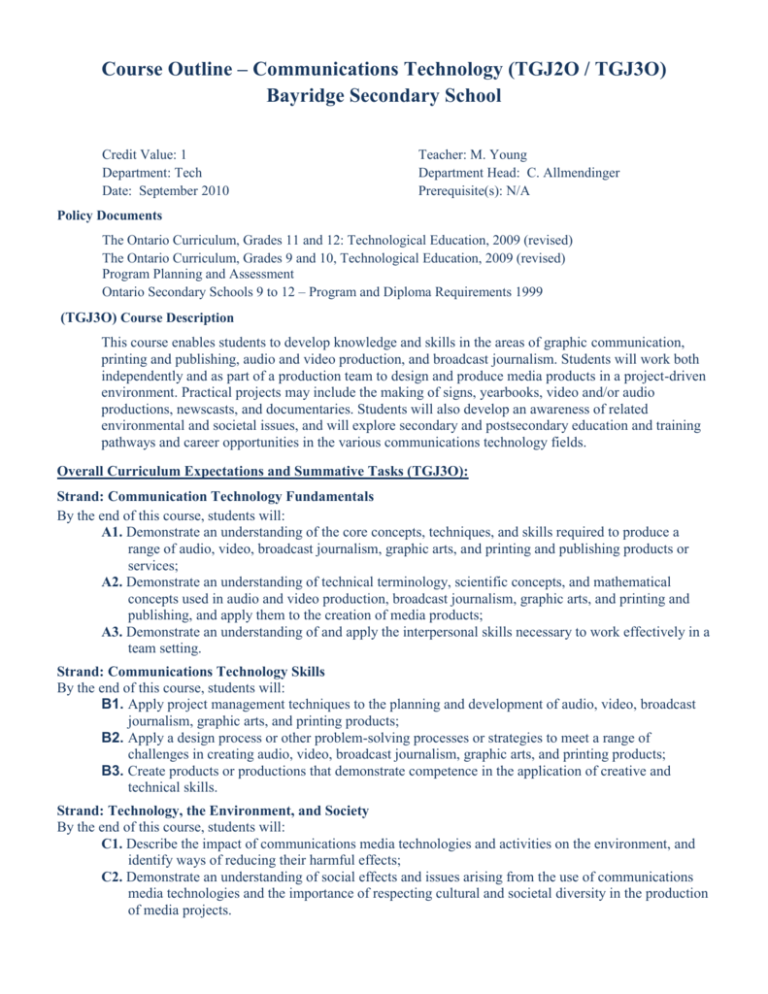
Course Outline – Communications Technology (TGJ2O / TGJ3O) Bayridge Secondary School Credit Value: 1 Department: Tech Date: September 2010 Teacher: M. Young Department Head: C. Allmendinger Prerequisite(s): N/A Policy Documents The Ontario Curriculum, Grades 11 and 12: Technological Education, 2009 (revised) The Ontario Curriculum, Grades 9 and 10, Technological Education, 2009 (revised) Program Planning and Assessment Ontario Secondary Schools 9 to 12 – Program and Diploma Requirements 1999 (TGJ3O) Course Description This course enables students to develop knowledge and skills in the areas of graphic communication, printing and publishing, audio and video production, and broadcast journalism. Students will work both independently and as part of a production team to design and produce media products in a project-driven environment. Practical projects may include the making of signs, yearbooks, video and/or audio productions, newscasts, and documentaries. Students will also develop an awareness of related environmental and societal issues, and will explore secondary and postsecondary education and training pathways and career opportunities in the various communications technology fields. Overall Curriculum Expectations and Summative Tasks (TGJ3O): Strand: Communication Technology Fundamentals By the end of this course, students will: A1. Demonstrate an understanding of the core concepts, techniques, and skills required to produce a range of audio, video, broadcast journalism, graphic arts, and printing and publishing products or services; A2. Demonstrate an understanding of technical terminology, scientific concepts, and mathematical concepts used in audio and video production, broadcast journalism, graphic arts, and printing and publishing, and apply them to the creation of media products; A3. Demonstrate an understanding of and apply the interpersonal skills necessary to work effectively in a team setting. Strand: Communications Technology Skills By the end of this course, students will: B1. Apply project management techniques to the planning and development of audio, video, broadcast journalism, graphic arts, and printing products; B2. Apply a design process or other problem-solving processes or strategies to meet a range of challenges in creating audio, video, broadcast journalism, graphic arts, and printing products; B3. Create products or productions that demonstrate competence in the application of creative and technical skills. Strand: Technology, the Environment, and Society By the end of this course, students will: C1. Describe the impact of communications media technologies and activities on the environment, and identify ways of reducing their harmful effects; C2. Demonstrate an understanding of social effects and issues arising from the use of communications media technologies and the importance of respecting cultural and societal diversity in the production of media projects. Strand: Professional Practice and Career Opportunities By the end of this course, students will: D1. Demonstrate an understanding of and apply safe work practices in the use of audio, video, broadcast journalism, graphic arts, and printing equipment; D2. Identify careers in audio and video production, broadcast journalism, graphic arts, and printing and publishing, and describe the skills, work habits, education, and training required for entry into employment in these fields. (TGJ2O) Course Description This course introduces students to communications technology from a media perspective. Students will work in the areas of TV/video and movie production, radio and audio production, print and graphic communications, photography, and interactive new media and animation. Student projects may include computer-based activities such as creating videos, editing photos, working with audio, cartooning, developing animations, and designing web pages. Students will also develop an awareness of environmental and societal issues related to communications technology, and will explore secondary and postsecondary education and training pathways and career opportunities in the various communications technology fields. Overall Curriculum Expectations and Summative Tasks (TGJ2O): Strand: Computer Technology Fundamentals By the end of this course, students will: A1. Demonstrate an understanding of the core concepts, techniques, and skills required to produce a range of communications media products or services; A2. Demonstrate an understanding of technical terminology, basic scientific concepts, and mathematical concepts used in communications technology and apply them to the creation of media products; A3. Demonstrate an understanding of and apply the interpersonal and communication skills necessary to work effectively in a team setting. Strand: Communications Technology Skills By the end of this course, students will: B1. Apply project management techniques to the planning and development of communications media products; B2. Apply a design process or other problem-solving processes to meet a range of challenges in communications technology; B3. Create products or productions that demonstrate competence in the application of creative and technical skills. Strand: Technology, the Environment, and Society By the end of this course, students will: C1. Describe the impact of communications media technologies and activities on the environment and identify ways of reducing their harmful effects; C2. Demonstrate an understanding of social effects and issues arising from the use of communications media technologies and the importance of representing cultural and social diversity in media productions. Strand: Professional Practice and Career Opportunities By the end of this course, students will: D1. Demonstrate an understanding of and apply safe work practices in communications technology activities; D2. Identify career opportunities in communications technology and demonstrate an understanding of the skills, work habits, education, and training required for entry into postsecondary programs or employment in these fields. Summative Assessment Tasks Description of Summative Assessment Task Graphic Design Summative: Graphic Portfolio Animation Summative: Stop Motion Animation 3D Modeling Summative: Backdrop Design Computer Aided Machining Summative: Product Design Video Production Summative: Short Film Method(s) of Evaluation Level 1,2,3,4 Value Rubric Written & Verbal feedback Rubric Written & Verbal feedback Rubric Written & Verbal feedback Terminology Quiz Rubric Written & Verbal feedback /10 Overall Expectations Evaluated 2O | 30 A1, B1, B2, B3, A1, A2, B2, C1, C2 C2, A1, B1, B2, B3, C2, D2 A1, A2, A3, B1, B2, A1, B1, B2, B3, D2 A3, B2, B4, D1, D3, A1, B1, B2, B3, D3 B2, B3, C1, C2, D1, D2, A1, B1, B2, B3, C2, A1, A2, B1, B2, B4 Note: The tasks listed above may change over the course of the semester to allow for teachers to respond to evidence of student learning. Students will be notified in advance of any changes to the summative assessment tasks. 30% Final Summative (or culminating) Activities Description of Final Summative Task Video Portfolio: Students create a video montage which showcases their work Literacy Component Method(s) of Evaluation Overall Expectations Evaluated 2O | 3O Value – 10% A1, A2, B1, B4, C1, C2, D2 A1, A3, B1, D1, D3, D4, D5 Film Production Value – 10% A3, B2, B3, B4 B2, D1, D4 Graphic Design Value – 10% B2, B3, D1 B2, B3, B4, D1, D3 Note: The tasks listed above may change over the course of the semester to allow for teachers to respond to evidence of student learning. Students will be notified in advance of any changes to the final summative tasks. Core Texts: There is no class text for this course. Websites, classroom periodicals, books, and information articles are provided as either the original or as a photocopy. Students wishing to provide current articles, related websites and information relevant to the course are encouraged to do so. Additional Resources: There may be an opportunity for guest speakers such as previous students enrolled in post-secondary Design programs to present their portfolios and other guest speakers in the related fields. Assessment and Evaluation Overview: 1. Learning Skills achievement: Learning skills are crucial to academic, career, and personal success. Students will be assessed frequently on their level of achievement of the following five learning skills: 2. Works Independently (e.g. accepts responsibility for completing tasks, following instructions, completes assignments on time and with care, uses time effectively) Teamwork (e.g. works willingly and cooperatively with others, is sensitive to the needs of others, takes responsibility for sharing the work, shows respect for the ideas and opinions of others) Organization (e.g. organizes work, creates a plan to complete tasks, demonstrates ability to organize and manage information) Work Habits/Homework (e.g. puts forth consistent effort, completes homework on time and with care, uses time effectively, perseveres with complex tasks that require effort) Initiative (e.g. responds to challenges and takes risks, seeks out opportunities for learning, identifies problems to solve, seeks additional information, generates questions for inquiry) Achievement of Overall Course Expectations: Diagnostic and Formative Assessment Tasks will be used throughout the course and may include anecdotal observations, questioning for understanding, quizzes, assignments, activities and investigations. Feedback provided on these assessment tasks will be used to help students and teachers to determine next steps to increase student mastery of the overall course expectations. These assessment tasks will not be used in the determination of grades. Summative Assessment Tasks will usually be used at or near the end of an instructional unit and may include unit tests, performance tasks, products, portfolios of student work, and projects. Evaluation of the summative assessment tasks will be used to determine the term grade and will be worth seventy percent (70%) of the final mark of the course. The mid-term mark will be derived for evaluation of the summative assessment tasks completed up until that point. As students progress through the course, the grade will represent the student’s most consistent level of achievement of overall expectations. Where overall expectations are evaluated more than once during the term, evidence of growth will be considered in determining the final grade. Final Summative Task will be used at o near the end of the course. Thirty percent (30%) of the final grade will be based on the evaluation of final summative tasks in the form of an examination and/or other culminating activities. The tasks will be based on overall expectations from all strands and across the categories of knowledge and understanding, thinking, application, and communication. Late or Missing Assignments: Students are expected to hand in assignments by the stated deadlines. If a student is unable to meet the deadline for a specific unavoidable reason, he or she should contact the teacher ahead of time to arrange either a later deadline, or an alternative assignment. It is important that all summative assessment tasks are completed so that there is sufficient evidence of achievement of the overall expectations for a credit to be granted. Academic Honesty: Academic dishonesty, including instances of plagiarism and cheating, are serious breaches of the school code of conduct. Any cases of academic dishonesty will be reported to the school administration and a plan of action will be implemented. Students may lose the opportunity to demonstrate achievement of course expectations by means of that assignment, but achievement of those expectations may still be demonstrated without penalty on other assignments. Whenever possible, alternate assignments will be used in addition to the disciplinary action. Disciplinary action may include: Referral to administration Documentation of the occurrence Informing the parent/guardian Counselling A compensatory task Academic assistance Suspension Loss of credit due to lack of sufficient evidence Teaching and Learning Strategies: Technological education involves knowing, doing, testing, designing and building, and evaluating. Teaching and learning approaches should address all of these areas. Students should use projects as a major means of achieving these expectations, and they should be provided with a combination of information and experience that will prepare them to make informed choices about the use of various technologies, to use technology wisely and well, and to solve technological problems. Students will be involved in: investigating technological products, systems, and processes; gaining knowledge of the principles and processes of technology; exploring needs that can be met through technology; creating and evaluating alternatives and modifications in relation to these needs; developing safe and efficient work habits; making products that satisfy defined specifications and standards or quality and safety; making connections between technology and society (past, present, and future); assessing related career opportunities and requirements; developing confidence and contribute to a technological society. Education for Exceptional Students: In planning courses in technological education, teachers must ensure that accommodations are made to meet the needs of exceptional students as set out in their Individual Education Plan. For example, teachers should recognize that some students may require focused and specialized directions, and advance practice in using equipment perhaps with the help of a peer. Issues relating to students’ ability to use equipment and read accompanying manuals must be addressed before students can be expected to participate effectively. Student Responsibility: It is the responsibility of the student enrolled in the course to be prepared each and every day (pen/pencil, notebook, binder). During a legitimate absence students are responsible for getting information they miss, handouts, and submitting or picking up marked work upon their return. Any student with an unexplained absence during a test or on a due date will miss the opportunity to write or submit the work. It is imperative in a computer lab that students save their work in the proper location (their own personal network space) and in a back-up location at all times: jump drive, flash drives, computer key etc. Saving of non-school related files and deletion of files other than your own is prohibited and will be dealt with accordingly. Please read the Computer Use Policy in your agenda book. It is also essential for students to clearly understand the value of the classroom environment. Headsets are NOT PERMITTED. When the opportunity for getting information is missed due to the use of headsets it will be the responsibility of that student to see other options in getting missed information. Cell phones are NOT PERMITTED in the classroom and must remain turned off at all times. Topics will be delivered in an orderly fashion. Students may be required to be divided into groups depending on the availability of the equipment. (i.e.: video cameras, digital camera and facilities.) Students will be taught software applications on a need-to-know basis for completion of assignments. Students are encouraged to also explore the software available for more knowledge and increased use for application to all their school projects.


